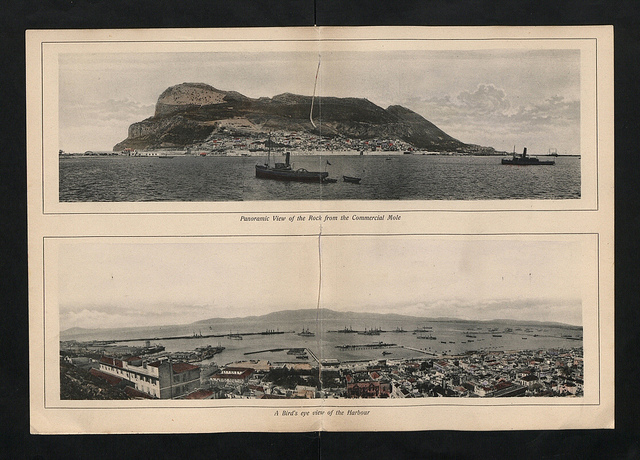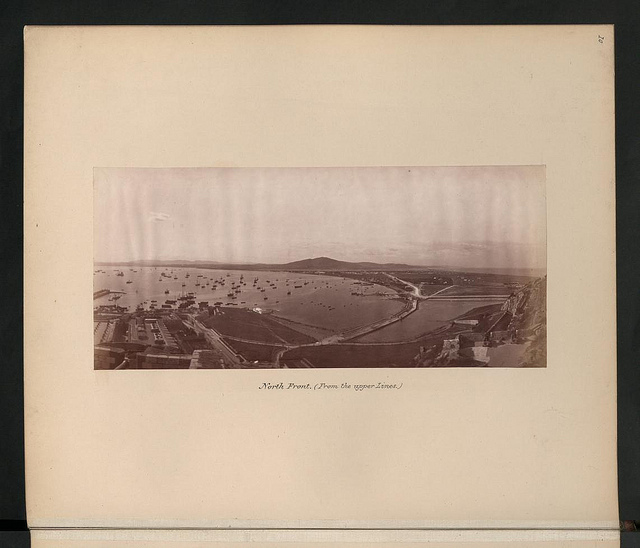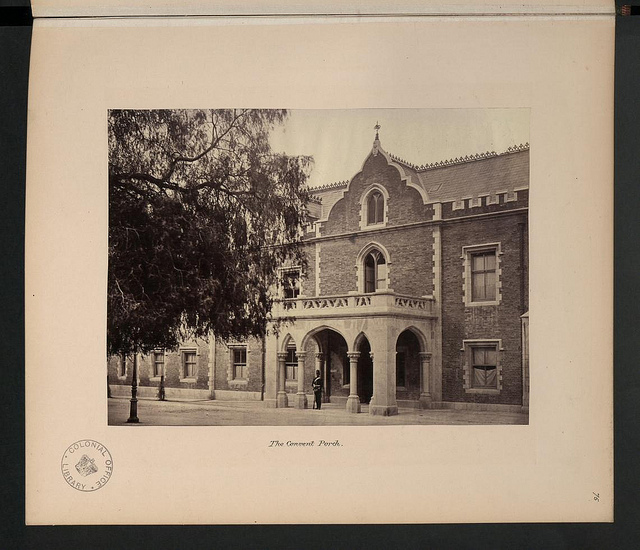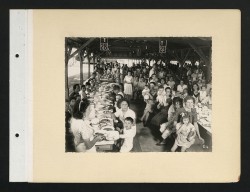Today it’s the turn of the small British Overseas Territory of Gibraltar to get the ‘through a lens’ treatment. If you’ve missed previous editions, The National Archives has been gradually releasing the contents of the Colonial Office Library’s photographic collection onto Flickr over the past two years. Our hope is that the people living there today will be able to tell us a bit more about the pictures and what they depict.
Almost 200 photos of Gibraltar, from the 19th century to the middle of the 20th, have gone online today, including rare colour photographs from the turn of the century.

Panoramic View of the Rock from the Commercial Mole (top), Gibraltar 1904 (catalogue ref: CO 1069/710)
At this point I should probably declare a personal interest. My father is a Gibraltarian and his family have lived on the Rock for many generations, so the photos released today offer a fascinating glimpse of the world my ancestors inhabited.
A lot of people assume Gibraltar is an island; in fact it’s attached to the rest of the Iberian Peninsula by a narrow strip of land referred to as the isthmus. This view (below) from the top of the Rock vividly illustrates just how narrow it could be and provides a sharp contrast to the modern airport and runway which visitors to Gibraltar will encounter there today.

North Front (From the Upper Lines), Gibraltar 1879 (catalogue ref: CO 1069/709)
As with Hong Kong, space is at a premium in Gibraltar, and anyone looking at these pictures, with even a passing knowledge of present-day Gibraltar, will be amazed at the growth of the settlement, not just upwards, but out into the sea through land reclamation.
Perhaps the most striking album in the collection is that containing views of Gibraltar collected by a colonial engineer called Captain Buckle in 1879. The timing is fortuitous; taken just a year after the 1878 census[ref] 1. Thanks to a project run by the University of Toronto Scarborough, the 1777, 1791 and 1878 censuses are available to search online for free via The Gibraltar Explorer. [/ref] of Gibraltar’s civilian population, meaning we have a good idea of the make-up of the community at the time.
It’s widely believed given its history that the inhabitants of Gibraltar are of predominantly Spanish or British descent. But in addition to these undoubtedly important influences, the census records confirm that modern-day Gibraltarians are a curiously Mediterranean mixture of Genoese and other Italians, Maltese, Minorcan and Portuguese. There are also significant local populations of Sephardic Jews, Moroccans, and Indians. This melting pot, shaped by history and commerce, has helped created the unique character, and peculiarities of language, of the Llanito.
At the time of the 1878 census, shortly before Captain Buckle began collecting his pictures, the civilian population of Gibraltar was 18,014; roughly half what it is today, of whom 75 per cent were ‘native-born’ Gibraltarians.
One such man was my great-great grandfather, John Norton, who was a 32-year old ‘office secretary’ at the time living at 1 Governor’s Lane with his wife, Catalina (née Dominguez), five children, his mother and two servants. The house remains standing today, opposite the court house and just round the corner from the Governor’s official residence, The Convent.

The Convent Porch, Gibraltar 1879 (catalogue ref: CO 1069/709)
Browsing photographs of these impressive colonial edifices – many of which survive to the present day; a running theme throughout the ‘through a lens’ collection – it’s easy to get a slightly skewed view of what life was like at the time for ordinary people.
Despite having a steady job with the Colonial Secretariat, my great-great grandfather’s life was not untouched by tragedy. Two of the five children recorded in the 1878 census, including a newborn baby, Mary, died in infancy, and in all seven of John and Catalina’s children perished before their sixth birthdays. Such misfortune, a consequence of over-crowding and a lack of fresh drinking water, among other things, was not untypical of the time. Even a decade later, in 1888, up to a third of all children born in Gibraltar died before the age of five[ref] 2. Community and Identity: The Making of modern Gibraltar since 1704 by Stephen Constantine. [/ref].
As a garrison town, the fortunes of the civilian population of Gibraltar were for a long time dependent on changes in military personnel and circumstances. The Second World War, as with so many parts of the Empire, proved to be a defining moment in Gibraltarian history. The majority of civilians – women, children and the elderly – were evacuated from their homes from May 1940 onwards. My father spent the majority of the war on the Portuguese island of Madeira. Others were not so lucky. My great-grandfather, Henry Norton, John and Catalina’s eldest surviving son, died in exile in Tangier, Morocco, and is buried there along with my great-grandmother. Other evacuees were sent to London – bizarrely at a time when Londoners were being moved out of the capital – Northern Ireland and Jamaica.

Children at lunch. Gibraltar Camp, Jamaica 1940-1941 (catalogue ref: CO 1069/371)
There are photographs of Gibraltarian wartime evacuees at a camp in Jamaica in our Caribbean Through a Lens collection and if anyone recognises any of the faces, we’d love to hear from you. The experience of the evacuees – exiled far from home and little knowing when, if ever, they’d be able to return – helped forge a stronger sense of Gibraltarian identity and led to calls for greater self-government at the end of the war which culminated in the Gibraltar Constitution Order of 1969.
Will you be showing more photos???
All of the photos of Gibraltar are available to view on Flickr: http://www.flickr.com/photos/nationalarchives/sets/72157632819019633/
More photographs from the Mediterranean and the Middle East will be added in the coming weeks. You can view all the sets released as part of the ‘through a lens’ project so far here: http://www.flickr.com/photos/nationalarchives/collections/72157632921688592/
On February 9, 1942 a German citizen namend Heinz Jürgen Themal arrived in Kensington,Jamaica, and went to Gibraltar Camp. He had passage on board of the Portuguese ship the “Serpa Pinto”. Is there anybode who reads this article on “the Rock” who knows what has become of this man? Being a Jew he was on the run for the Nazi’s. In Jamaica there seem te be no known files on refugees before 1943.
If you google him there is a US Naturalisation request in 1953 under his name (he seems to have changed his name to Henry James Themal) in New York.
Good morning Mister Norton. I’m looking for a photo with the image of Gibraltar Rock with the big advertising poster of Olio Sasso, about which I’ve read in many publications. It’s for an historical research. Can you maybe help me?